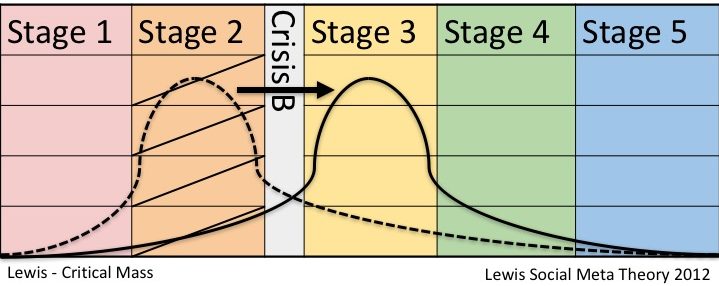A revolution occurs when a critical mass of individuals evolve beyond the social structures of the society. Critical mass is the tipping point where the statistical mode of the population is capable of behaving beyond the existing structure that satisfies previous societal needs. When the population becomes more educated, desires higher needs and motivated by different desires; the organization goes through a crisis causing a revolution bringing society into the next evolutionary stage.
In the following diagram, the dashed curve line represents the current stages of various social sciences of an individual, organization, or society. The dotted line represents health relative to the structure around the behavior of the group. When the statistical mode matches the organizational structures in place to support them, the group is considered to be healthy. The structures are logically consistent with the needs of the group.
As the behavior of the society evolves in aggregate represented by the solid bell curve, and the social constructs in place do not, it forms a state of crisis ripe for revolution. In the revolution, all of the social constructs are replaced with constructs appropriate for the newly evolved population. This can manifest itself as physical revolution, or as organizational revolution.

Figure a. Critical Mass
Much like individuals, organizations and society must go through these revolutions themselves for the critical learning to occur. Creating more evolved social structure for a population that is not behaviorally ready for the change will cause the society to return to its previous stages. Individuals who need to be told what to do in order to keep societal order cannot live in a social structure of freedom and responsibility. Revolutions enable groups to go through the process of creating a new structure on their own, making living into a new future possibility part of how they behave.